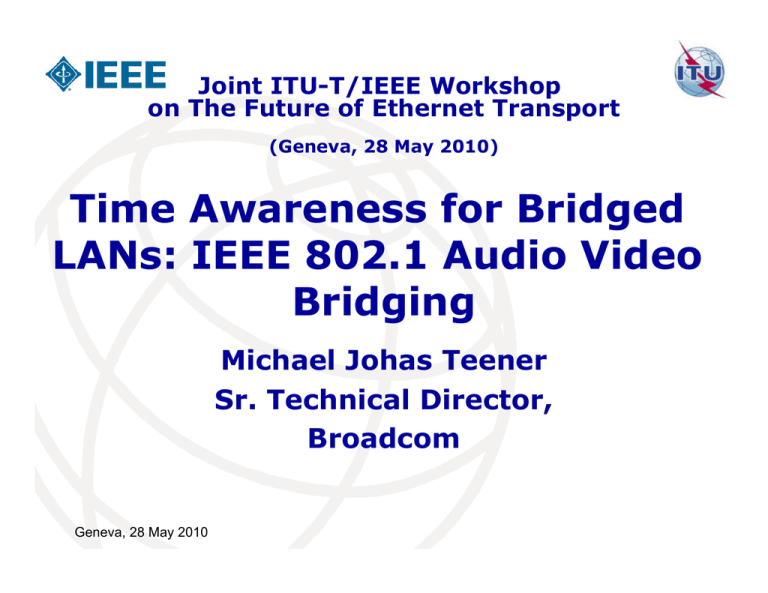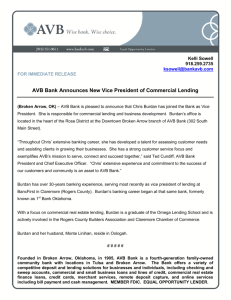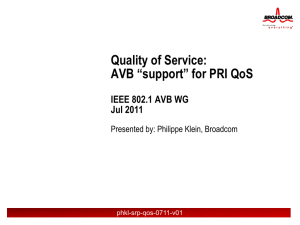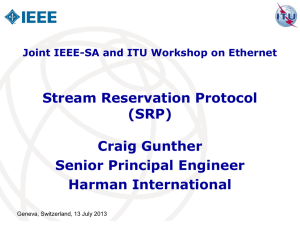Time Awareness for Bridged LANs: IEEE 802.1 Audio Video Bridging Michael Johas Teener
advertisement

Joint ITU-T/IEEE Workshop on The Future of Ethernet Transport (Geneva, 28 May 2010) Time Awareness for Bridged LANs: IEEE 802.1 Audio Video Bridging Michael Johas Teener Sr. Technical Director, Broadcom Geneva, 28 May 2010 Agenda !" 802.1 AV Bridging Task Group !" What we do Why is it needed? ! " What is AV Bridging? ! " Where will it be used? ! " Possible interactions with ITU efforts !" Geneva, 28 May 2010 2 IEEE 802.1 Audio Video Bridging Task Group !" !" Formed in late 2005 to provide the specifications that will allow timesynchronized low latency streaming services through 802 networks Four projects: !" P802.1AS: Time Synchronization (in sponsor ballot) !" !" !" !" Discussed in the next presentation P802.1Qat: Stream Reservation (in sponsor ballot) IEEE Std 802.1Qav-2009: Forwarding and Queuing for Time-Sensitive Streams P802.1BA: AVB Systems (in development) Geneva, 28 May 2010 3 Why is it needed? !" Common IT-oriented networks have inadequate QoS controls !" !" !" !" all use 802.1 “priority” (actually, “traffic class”) no time-based services, no standardized queuing or traffic shaping no guarantees, timing synchronization difficult Adding QoS to layer 2 networks is not enough !" !" E.g., adding streaming QoS to G.hn only provides better services on a particular G.hn subnet … QoS lost going to WiFi or Ethernet QoS is a NETWORK problem, not just a link problem Geneva, 28 May 2010 4 Audio Video Bridging AVB end point Streaming QoS only guaranteed in AVB cloud end point legacy bridge peer device not AVB capable AVB end point devices outside of AVB cloud still communicate with all other devices using legacy "best effort" QoS !" AVB bridge half duplex link can't do AVB Enet hub end point AVB end point AVB switch AVB switch end point AVB "cloud" (defended network) AVB end point AVB end point AVB end point filtering/retagging active best effort link streaming QoS link AVB is based on 802.1Q bridges !" The bridges connect together LANs that use different layer 2 technologies: Ethernet, WiFi, MoCA, G.hn Geneva, 28 May 2010 5 AVB provides … !" Bounded latency … !" For 100Mbit/sec it’s about 250 usec per link, for 1Gbit/sec it’s about 25 usec link … with no dropped packets due to congestion … ! " … for streams that do not exceed their maximum bandwidth established using the end-to-end “Stream Reservation Protocol” ! " PLUS a high-quality time reference !" Geneva, 28 May 2010 6 AVB Will Be Used … !" … in professional audio/video environments !" !" … in automotive applications !" !" Infotainment, sensor systems … in consumer electronics !" !" Audio and video studios, stadiums, hospitals, airports, live performances Home A/V networking and interconnects … in industrial systems !" Sensors, actuators, motion control Geneva, 28 May 2010 7 AVB Provides Carrier Networks … !" Precise synchronization services !" !" !" Connection-oriented services !" !" !" 802.1AS - IEEE 1588v2 as applied to 802.1 bridged networks. Much better MTIE than needed for SONET 802.1Qat - Stream Reservation Protocol to manage streams 802.1Qav - Guaranteed latency and bandwidth for established streams Removes the need for external PHY-level synchronization !" !" !" Any 802.3 PHY will work, nothing special needed, full configuration flexibility Support for other full-duplex point-to-point PHYs trivial Support for shared media MACs allowed (EPON, 802.11, MoCA) via sublayer definition Geneva, 28 May 2010 8 Putting it All Together CE CE TDM IWF IWF TDM Differential Timing Messages Packet Switched Network IWF IWF Recovered TDM timing based on the differential timing messages TDM CE CE TDM 802.1at/av Synchronization Network TDM Service Clocks PRC !" 802.1AS Time Sync Synchronization Network PRC AVB supports multiple independently clocked streams/domains Geneva, 28 May 2010 9 Thank you! Geneva, 28 May 2010





